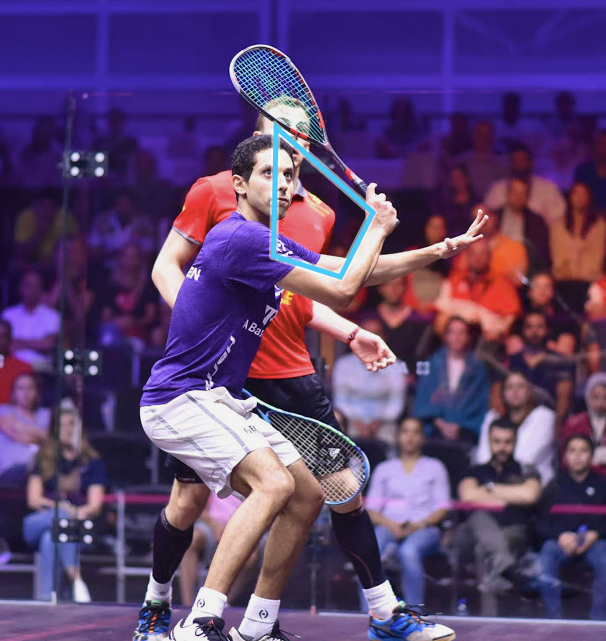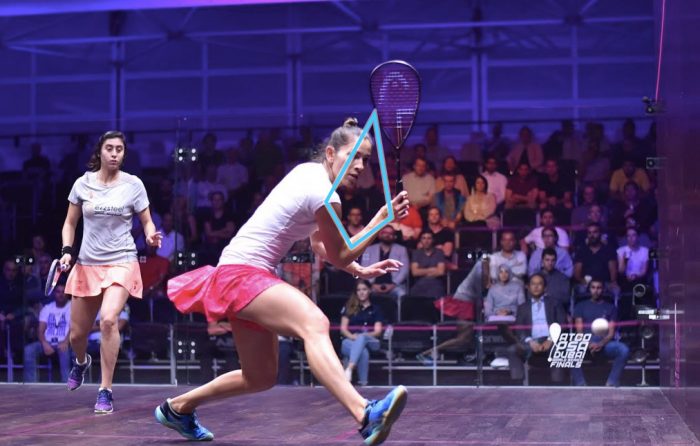I’m a bit of a technique geek. I get excited by seeing a really good swing in action and sometimes get caught up with what the swing looks like as opposed to where the ball ends up.
This is wrong, because if someone is hitting a target time after time despite not having the most aesthetically pleasing swing then they must doing something right.
However, I am a firm believer that if you create and aesthetically pleasing swing where all the bio-mechanics are working as they should, then you will hit the ball more accurately, more consistently and with more power.
For those of you who follow the Facebook page, you will notice that I’m a big fan of shoulder rotation on the backhand side and often highlight this whenever I see a photo of someone doing this correctly. For me having good shoulder rotation at the beginning of the backhand swing is fundamental. It’s where all your power and all your consistency comes from.
I’ve been on court many times with people for the first time and I ask them what they want to work on. “It’s my backhand, I just don’t seem to be able to generate any power and always drag the ball into the middle of the court,” they say. Without so much as seeing them hit the ball, it’s obvious what the issue is… A lack of shoulder rotation.
 By rotating towards the back wall and getting your shoulder to sit under your chin at the beginning of the swing, you are naturally loading up your Trap and your deltoid so that they want to pull your arm (and your racket) back through the line of the ball. You also have the benefit of your torso wanting to come back into its natural position meaning that you are able to generate power at the beginning of the swing as opposed to at the end.
By rotating towards the back wall and getting your shoulder to sit under your chin at the beginning of the swing, you are naturally loading up your Trap and your deltoid so that they want to pull your arm (and your racket) back through the line of the ball. You also have the benefit of your torso wanting to come back into its natural position meaning that you are able to generate power at the beginning of the swing as opposed to at the end.
By not rotating at the beginning of the swing on the backhand you will find yourself trying to generate power at the end of the swing. So this means that following impact, rather than maintaining a position where your shoulders face the sidewall and you end up following through to your target, you will look to generate extra power by rotating the torso towards the front wall.
This results in the follow-through coming across your body and you having to compensate by altering the angle of the racket face in order to get the ball going straight down the line. Now, this can work and will work well, from time to time, it however will not lead to consistency!
Good squash players consistently do things better than lesser squash players and if you want to be a good squash player you want to be able to hit a straight drive that, 9 times out of 10 will run straight down the sidewall. With a lack of shoulder rotation, this figure may only be 4/10 with you giving strokes away and dragging the ball into the middle of the court. If that’s the case you’re going to be doing a lot of work and your opponent will be enjoying their time volleying from the T.
How to teach backhand shoulder rotation?
Whilst coaching alongside Hadrian Stiff at his Elite Squash Academy in Bristol I came up with the concept of the backhand diamond position. The diamond position, unsurprisingly, is based on the concept of creating a diamond shape at the beginning of your backhand swing.

The racket head makes the top point of the diamond whilst the wrist and shoulder make up the two side points with the elbow creating the final point at the lowest point of the diamond.
By creating this diamond position, you are forcing yourself to rotate your shoulder (remember, this is where power and consistency comes from) as you approach the ball at the beginning of the swing.
What are the 4 key points in creating this diamond position?
- Get your shoulder in a starting position so that it sits underneath your chin at the beginning of the swing.
- Maintain a ‘semi cocked’ wrist position so that the racket head is naturally up above the ball. (I’ve had many debates with Peter about cocked vs uncocked and we have compromised on the fact that ‘semi cocked’ is a reasonable term to use as it means the racket head is up, yet you are able to adapt and adjust if the ball is away from you in an awkward position).
- Rotate the upper body towards the back corner at the beginning of the swing.
- Get the elbow into as low a starting position as possible. This may sound odd but try it, the lower you get you elbow, the higher the racket head actually ends up at the beginning of the swing.
 By using this ‘Diamond Position‘ as a teaching point over the last couple of years I have had a great deal of success in improving many players backhands. It’s easy to visualise and naturally gets all body parts into the right place at the beginning of the swing.
By using this ‘Diamond Position‘ as a teaching point over the last couple of years I have had a great deal of success in improving many players backhands. It’s easy to visualise and naturally gets all body parts into the right place at the beginning of the swing.
Next time you are on court have a think about this position and see if it improves the consistency of your hitting on the backhand side.
Jethro Binns
SquashSkills Founder
Want to see it in video form?
Check out the video as part for the backhand technique playlist and see how the whole swing links together
Watch now